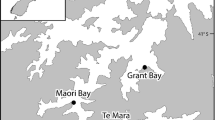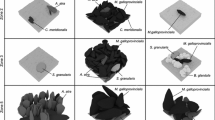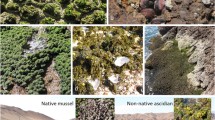Abstract
Non-native species have invaded coastal systems worldwide, altering community structures and ecosystem functioning. One of the most widely distributed marine invaders is the kelp Undaria pinnatifida. In Australasia, Undaria is a large annual kelp that typically has a unimodal growth pattern characterized by high cover during late-winter and spring. It is possible that Undaria co-occurs with mussels and impacts the biodiversity of mussel assemblages on rocky reefs, especially given its presence on mussel farms. Here, we tested whether Undaria and mussels co-occurred on rocky reefs at different temporal and spatial scales, and whether Undaria affects the diversity of mussel-associated small mobile invertebrates. Analyses of survey data showed that individuals of Undaria are often attached to, or interspersed around, mussel aggregations in the low intertidal zone where Undaria was found at similar abundances in its typical winter growth and summer senescence seasons. We hypothesize that this unexpected pattern is caused by overlapping generations coupled with longer growing seasons, potentially triggered by localized higher wave action, rather than individual plants persisting for an entire year. Analyses of Undaria holdfasts and non-living mimics of Undaria holdfasts, showed that live and large holdfasts, in particular, alter and increase small-scale diversity of mobile invertebrates where Undaria co-occurs with mussels. We conclude that Undaria has a longer temporal presence where it co-occurs with mussels and that Undaria alter mussel-associated communities of small mobile invertebrates.






Similar content being viewed by others
References
Altieri AH, Silliman BR, Bertness MD (2007) Hierarchical organization via a facilitation cascade in intertidal cordgrass bed communities. Am Nat 169:195–206. https://doi.org/10.1086/510603
Anderson MJ (2005) Permutational multivariate analysis of variance. Department of Statistics, University of Auckland, Auckland, vol 26, pp 32–46
Anderson R, Carrick P, Levitt G, Share A (1997) Holdfasts of adult kelp Ecklonia maxima provide refuges from grazing for recruitment of juvenile kelps. Mar Ecol Prog Ser 159:265–273
Arnold M, Teagle H, Brown MP, Smale DA (2016) The structure of biogenic habitat and epibiotic assemblages associated with the global invasive kelp Undaria pinnatifida in comparison to native macroalgae. Biol Invasions 18:661–676
Bishop MJ, Byers JE, Marcek BJ, Gribben PE (2012) Density-dependent facilitation cascades determine epifaunal community structure in temperate Australian mangroves. Ecology 93:1388–1401
Bollen M, Battershill CN, Pilditch CA, Bischof K (2017) Desiccation tolerance of different life stages of the invasive marine kelp Undaria pinnatifida: Potential for overland transport as invasion vector. J Exp Mar Biol Ecol 496:1–8
Bologna PA, Heck KL (1999) Macrofaunal associations with seagrass epiphytes—relative importance of trophic and structural characteristics. J Exp Mar Biol Ecol 242:21–39
Bulleri F, Airoldi L, Branca G, Abbiati M (2006) Positive effects of the introduced green alga, Codium fragile ssp. tomentosoides, on recruitment and survival of mussels. Mar Biol 148:1213–1220
Bulleri F, Balata D, Bertocci I, Tamburello L, Benedetti-Cecchi L (2010) The seaweed Caulerpa racemosa on Mediterranean rocky reefs: from passenger to driver of ecological change. Ecology 91:2205–2212. https://doi.org/10.1890/09-1857.1
Buschbaum C, Chapman AS, Saier B (2006) How an introduced seaweed can affect epibiota diversity in different coastal systems. Mar Biol 148:743–754
Carroll JM, Peterson BJ, Bonal D, Weinstock A, Smith CF, Tettelbach ST (2010) Comparative survival of bay scallops in eelgrass and the introduced alga, Codium fragile, in a New York estuary. Mar Biol 157:249–259
Casas G, Scrosati R, Piriz ML (2004) The invasive kelp Undaria pinnatifida (Phaeophyceae, Laminariales) reduces native seaweed diversity in Nuevo Gulf (Patagonia, Argentina). Biol Invasions 6:411–416
Castric-Fey A, Girard A, L’Hardy-Halos MT (1993) The distribution of Undaria pinnatifida (Phaeophyceae, Laminariales) on the coast of St. Malo (Brittany, France). Bot Mar 36:351–358
Clarke K, Warwick R (1994) An approach to statistical analysis and interpretation. Change Mar Communities 2:117–143
Crooks JA (2002) Characterizing ecosystem-level consequences of biological invasions: the role of ecosystem engineers. Oikos 97:153–166. https://doi.org/10.1034/j.1600-0706.2002.970201.x
Epstein G, Smale DA (2017) Undaria pinnatifida: a case study to highlight challenges in marine invasion ecology and management. Ecol Evol 7:8624–8642
Feary DA, Wellenreuther M, Clements K (2009) Trophic ecology of New Zealand triplefin fishes (family Tripterygiidae). Mar Biol 156:1703–1714
Forrest BM, Blakemore KA (2006) Evaluation of treatments to reduce the spread of a marine plant pest with aquaculture transfers. Aquaculture 257:333–345. https://doi.org/10.1016/j.aquaculture.2006.03.021
Forrest BM, Taylor MD (2002) Assessing invasion impact: survey design considerations and implications for management of an invasive marine plant. Biol Invasions 4:375–386
Forrest BM, Brown SN, Taylor MD, Hurd CL, Hay CH (2000) The role of natural dispersal mechanisms in the spread of Undaria pinnatifida (Laminariales, Phaeophyceae). Phycologia 39:547–553. https://doi.org/10.2216/i0031-8884-39-6-547.1
Gallardo B (2014) Europe’s top 10 invasive species: relative importance of climatic, habitat and socio-economic factors. Ethol Ecol Evol 26:130–151. https://doi.org/10.1080/03949370.2014.896417
Gartner A, Tuya F, Lavery PS, McMahon K (2013) Habitat preferences of macroinvertebrate fauna among seagrasses with varying structural forms. J Exp Mar Biol Ecol 439:143–151
Hall M, Bell S (1988) Response of small motile epifauna to complexity of epiphytic algae on seagrass blades. J Mar Res 46:613–630
Hay CH (1990) The dispersal of sporophytes of Undaria pinnatifida by coastal shipping in New Zealand, and implications for further dispersal of Undaria in France. Brit Phycol J 25:301–313. https://doi.org/10.1080/00071619000650331
Hay C, Villouta E (1993) Seasonality of the adventive Asian kelp Undaria pinnatifida in New Zealand. Bot Mar 36:461–476
Hurd CL (2000) Water motion, marine macroalgal physiology, and production [Review]. J Phycol 36:453–472
Irigoyen A, Trobbiani G, Sgarlatta M, Raffo M (2011) Effects of the alien alga Undaria pinnatifida (Phaeophyceae, Laminariales) on the diversity and abundance of benthic macrofauna in Golfo Nuevo (Patagonia, Argentina): potential implications for local food webs. Biol Invasions 13:1521–1532. https://doi.org/10.1007/s10530-010-9910-9
James K, Shears NT (2016a) Population ecology of the invasive kelp Undaria pinnatifida towards the upper extreme of its temperature range. Mar Biol 163:225
James K, Shears NT (2016b) Proliferation of the invasive kelp Undaria pinnatifida at aquaculture sites promotes spread to coastal reefs. Mar Biol 163:1–12. https://doi.org/10.1007/s00227-015-2811-9
James K, Kibele J, Shears NT (2015) Using satellite-derived sea surface temperature to predict the potential global range and phenology of the invasive kelp Undaria pinnatifida. Biol Invasions 17:3393–3408
Jiménez RS, Hepburn CD, Hyndes GA, McLeod RJ, Taylor RB, Hurd CL (2015) Do native subtidal grazers eat the invasive kelp Undaria pinnatifida? Mar Biol 162: 0
Kennedy V (1976) Desiccation, higher temperatures and upper intertidal limits of three species of sea mussels (Mollusca: Bivalvia) in New Zealand. Mar Biol 35:127–137
Lilley S, Alestra T, Hickford M, Schiel DR (2016) Biodiversity and community composition of rocky intertidal areas within Whakaraupō/Lyttelton Harbour. Report prepared for Environment Canterbury, p 114
Lowe S, Browne M, Boudjelas S, De Poorter M (2000) 100 of the world’s worst invasive alien species: a selection from the global invasive species database. Invasive Species Specialist Group Auckland, New Zealand
Maggi E, Benedetti-Cecchi L, Castelli A, Chatzinikolaou E, Crowe T, Ghedini G, Kotta J, Lyons D, Ravaglioli C, Rilov G, Rindi L, Bulleri F (2015) Ecological impacts of invading seaweeds: a meta-analysis of their effects at different trophic levels. Divers Distrib 21:1–12
Molnar JL, Gamboa RL, Revenga C, Spalding MD (2008) Assessing the global threat of invasive species to marine biodiversity. Front Ecol Environ 6:485–492
Morelissen B, Dudley BD, Geange SW, Phillips NE (2013) Gametophyte reproduction and development of Undaria pinnatifida under varied nutrient and irradiance conditions. J Exp Mar Biol Ecol 448:197–206
Morita T, Kurashima A, Maegawa M (2003) Temperature requirements for the growth and maturation of the gametophytes of Undaria pinnatifida and U. undarioides (Laminariales, Phaeophyceae). Phycol Res 51:154–160
Na YJ, Jeon DV, Han SJ, Maranguy CAO, An DS, Cha HK, Lee JB, Yang JH, Lee HW, Choi HG (2016) Crossed effects of light and temperature on the growth and maturation of gametophytes in Costaria costata and Undaria pinnatifida. Korean J Fish Aquat Sci 49:190–197
Nanba N, Fujiwara T, Kuwano K, Ishikawa Y, Ogawa H, Kado R (2011) Effect of water flow velocity on growth and morphology of cultured Undaria pinnatifida sporophytes (Laminariales, Phaeophyceae) in Okirai Bay on the Sanriku coast, Northeast Japan. J Appl Phycol 23:1023–1030
Nyberg CD, Thomsen MS, Wallentinus I (2009) Flora and fauna associated with the introduced red alga Gracilaria vermiculophylla. Eur J Phycol 44:395–403
O’Connor NE, Crowe TP, McGrath D (2006) Effects of epibiotic algae on the survival, biomass and recruitment of mussels, Mytilus L. (Bivalvia: Mollusca). J Exp Mar Biol Ecol 328:265–276. https://doi.org/10.1016/j.jembe.2005.07.013
Parker IM, Simberloff D, Lonsdale W, Goodell K, Wonham M, Kareiva P, Williamson M, Von Holle B, Moyle P, Byers J (1999) Impact: toward a framework for understanding the ecological effects of invaders. Biol Invasions 1:3–19
Pereyra PJ, Arias M, Gonzalez R, Narvarte M (2014) Moving forward: the Japanese kelp Undaria pinnatifida (Harvey) Suringar, 1873 expands in northern Patagonia, Argentina. BioInvasions Record 3
Pereyra PJ, Narvarte M, Tatián M, González R (2015) The simultaneous introduction of the tunicate Styela clava (Herdman, 1881) and the macroalga Undaria pinnatifida (Harvey) Suringar, 1873, in northern Patagonia. BioInvasions Rec 4
Pereyra PJ, de la Barra P, Gastaldi M, Saad JF, Firstater FN, Narvarte MA (2017) When the tiny help the mighty: facilitation between two introduced species, a solitary ascidian and a macroalga in northern Patagonia, Argentina. Mar Biol 164:185
Peteiro C, Freire Ó (2011) Effect of water motion on the cultivation of the commercial seaweed Undaria pinnatifida in a coastal bay of Galicia, Northwest Spain. Aquaculture 314:269–276
Peteiro C, Sánchez N, Martínez B (2016) Mariculture of the Asian kelp Undaria pinnatifida and the native kelp Saccharina latissima along the Atlantic coast of Southern Europe: an overview. Algal Res 15:9–23. https://doi.org/10.1016/j.algal.2016.01.012
Pinkerton M, Lundquist C, Duffy C, Freeman D (2008) Trophic modelling of a New Zealand rocky reef ecosystem using simultaneous adjustment of diet, biomass and energetic parameters. J Exp Mar Biol Ecol 367:189–203
Primo C, Hewitt CL, Campbell ML (2010) Reproductive phenology of the introduced kelp Undaria pinnatifida (Phaeophyceae, Laminariales) in Port Phillip Bay (Victoria, Australia). Biol Invasions 12:3081–3092. https://doi.org/10.1007/s10530-010-9700-4
Ramus AP, Silliman BR, Thomsen MS, Long ZT (2017) An invasive foundation species enhances multifunctionality in a coastal ecosystem. Proc Natl Acad Sci 114:8580–8585
Saito Y (1975) Practical significance of algae in Japan. Undaria. In: Tohida J, Hirose H (eds) Advance of phycology in Japan. VEB Gustav Fischer Verlag, Jena, pp 304–320
Sardiña P, Cataldo DH, Boltovskoy D (2009) Effects of conspecifics on settling juveniles of the invasive golden mussel, Limnoperna fortunei. Aquat Sci 71:479–486. https://doi.org/10.1007/s00027-009-0103-5
Schaffelke B, Campbell ML, Hewitt CL (2005) Reproductive phenology of the introduced kelp Undaria pinnatifida (Phaeophyceae, Laminariales) in Tasmania, Australia. Phycologia 44:84–94
Schiel DR, Thompson GA (2012) Demography and population biology of the invasive kelp Undaria pinnatifida on shallow reefs in southern New Zealand. J Exp Mar Biol Ecol 434:25–33
Sliwa C, Johnson CR, Hewitt CL (2006) Mesoscale dispersal of the introduced kelp Undaria pinnatifida attached to unstable substrata. Bot Mar 49:396–405. https://doi.org/10.1515/bot.2006.051
South PM, Thomsen MS (2016) The ecological role of invading Undaria pinnatifida: an experimental test of the driver-passenger models. Mar Biol 163:1–15. https://doi.org/10.1007/s00227-016-2948-1
South PM, Lilley S, Tait LW, Alestra T, Hickford MJH, Thomsen MS, Schiel DR (2016) Transient effects of an invasive kelp on the community structure and primary productivity of an intertidal assemblage. Mar Freshw Res 67:103–112
South PM, Floerl O, Forrest BM, Thomsen MS (2017) A review of three decades of research on the invasive kelp Undaria pinnatifida in Australasia: an assessment of its success, impacts and status as one of the world’s worst invaders. Mar Environ Res
Steneck RS, Graham MH, Bourque BJ, Corbett D, Erlandson JM, Estes JA, Tegner MJ (2002) Kelp forest ecosystems: biodiversity, stability, resilience and future. Environ Conserv 29:436–459. https://doi.org/10.1017/s0376892902000322
Strayer DL, Eviner VT, Jeschke JM, Pace ML (2006) Understanding the long-term effects of species invasions. Trends Ecol Evol 21:645–651. https://doi.org/10.1016/j.tree.2006.07.007
Suárez-Jiménez R, Hepburn CD, Hyndes GA, McLeod RJ, Taylor RB, Hurd CL (2017) The invasive kelp Undaria pinnatifida hosts an epifaunal assemblage similar to native seaweeds with comparable morphologies. Mar Ecol Prog Ser 582:45–55
Tait LW, South PM, Lilley SA, Thomsen MS, Schiel DR (2015) Assemblage and understory carbon production of native and invasive canopy-forming macroalgae. J Exp Mar Biol Ecol 469:10–17. https://doi.org/10.1016/j.jembe.2015.04.007
Tamburello L, Maggi E, Benedetti-Cecchi L, Bellistri G, Rattray AJ, Ravaglioli C, Rindi L, Roberts J, Bulleri F (2015) Variation in the impact of non-native seaweeds along gradients of habitat degradation: a meta-analysis and an experimental test. Oikos 124:1121–1131
Teagle H, Hawkins SJ, Moore PJ, Smale DA (2017) The role of kelp species as biogenic habitat formers in coastal marine ecosystems. J Exp Mar Biol Ecol
Teso SV, Bigatti G, Casas GN, Piriz ML, Penchaszadeh PE (2009) Do native grazers from Patagonia, Argentina, consume the invasive kelp Undaria pinnatifida. Revista del Museo Argentino de Ciencias Naturales 11:7–14
Thiel M, Vásquez JA (2000) Are kelp holdfasts islands on the ocean floor?–Indication for temporarily closed aggregations of peracarid crustaceans. Hydrobiologia 440:45–54
Thompson GA (2004) Mechanisms of invasion and persistence of the intertidal kelp Undaria pinnatifida (Harvey) Suringar within intertidal areas of southern New Zealand. PhD thesis
Thomsen MS, McGlathery K (2005) Facilitation of macroalgae by the sedimentary tube forming polychaete Diopatra cuprea. Estuar Coast Shelf Sci 62:63–73
Thompson GA, Schiel DR (2012) Resistance and facilitation by native algal communities in the invasion success of Undaria pinnatifida. Mar Ecol Prog Ser 468:95–105. https://doi.org/10.3354/meps09995
Thomsen MS (2010) Experimental evidence for positive effects of invasive seaweed on native invertebrates via habitat-formation in a seagrass bed. Aquat Invasions 5:341–346
Thomsen MS, Wernberg T, Tuya F, Silliman BR (2009) Evidence for impacts of non-indigenous macroalgae; a meta-analysis of experimental field studies. J Phycol 45:812–819. https://doi.org/10.1111/j.1529-8817.2009.00709.x
Thomsen MS, Wernberg T, Altieri AH, Tuya F, Gulbransen D, McGlathery KJ, Holmer M, Silliman BR (2010) Habitat cascades: the conceptual context and global relevance of facilitation cascades via habitat formation and modification. Integr Comp Biol 50:158–175
Thomsen MS, Olden JD, Wernberg T, Griffin JN, Silliman BR (2011) A broad framework to organize and compare ecological invasion impacts. Environ Res 111:899–908
Thomsen MS, Hildebrand T, South PM, Foster T, Siciliano A, Oldach E, Schiel DR (2016a) A sixth-level habitat cascade increases biodiversity in an intertidal estuary. Ecol Evol. https://doi.org/10.1002/ece3.2499
Thomsen MS, Wernberg T, South PM, Schiel DR (2016b) Non-native seaweeds drive changes in marine coastal communities around the world Seaweed Phylogeography. Springer, Berlin, pp 147–185
Thornber CS, Kinlan BP, Graham MH, Stachowicz JJ (2004) Population ecology of the invasive kelp Undaria pinnatifida in California: environmental and biological controls on demography. Mar Ecol Prog Ser 268:69–80
Tuya F, Larsen K, Platt V (2011) Patterns of abundance and assemblage structure of epifauna inhabiting two morphologically different kelp holdfasts. Hydrobiologia 658:373–382
Uwai S, Nelson W, Neill K, Wang WD, Aguilar-Rosas LE, Boo SM, Kitayama T, Kawai H (2006) Genetic diversity in Undaria pinnatifida (Laminariales, Phaeophyceae) deduced from mitochondria genes—origins and succession of introduced populations. Phycologia 45:687–695. https://doi.org/10.2216/05-66.1
Valentine JP, Johnson CR (2004) Establishment of the introduced kelp Undaria pinnatifida following dieback of the native macroalga Phyllospora comosa in Tasmania, Australia. Mar Freshw Res 55:223–230
Valentine JP, Johnson CR (2005) Persistence of the exotic kelp Undaria pinnatifida does not depend on sea urchin grazing. Mar Ecol Prog Ser 285:43–55
Vinther HF, Holmer M (2008) Experimental test of biodeposition and ammonium excretion from blue mussels (Mytilus edulis) on eelgrass (Zostera marina) performance. J Exp Mar Biol Ecol 364:72–79
Watson DM, Herring M (2012) Mistletoe as a keystone resource: an experimental test. Proc R Soc B Biol Sci 279:3853–3860
Wernberg T, Thomsen MS, Staehr PA, Pedersen MF (2004) Epibiota communities of the introduced and indigenous macroalgal relatives Sargassum muticum and Halidrys siliquosa in Limfjorden (Denmark). Helgol Mar Res 58:154
Williams SL, Smith JE (2007) A global review of the distribution, taxonomy, and impacts of introduced seaweeds. Annu Rev Ecol Evol Syst 38:327–359
Funding
This study was funded by the Marsden Fund of The Royal Society of New Zealand (13-UOC-106 to MST). MST, DRS and TA gratefully acknowledge support from the Brian Mason Trust for the project, ‘How do mussel beds persist in the Canterbury region?’. PMS is funded by Cawthron Institute.
Author information
Authors and Affiliations
Corresponding author
Ethics declarations
Conflict of interest
Mads S Thomsen declares that he has no conflict of interest. Tommaso Alestra declares that he has no conflict of interest. David Brockerhoff declares that he has no conflict of interest. Stacie A. Lilley declares that she has no conflict of interest. Paul M. South declares that he has no conflict of interest. David R. Schiel declares that he has no conflict of interest.
Human and animal rights
All applicable international, national, and/or institutional guidelines for the care and use of animals were followed.
Additional information
Responsible Editor: F. Bulleri.
Reviewed by D. Davoult and an undisclosed expert.
Rights and permissions
About this article
Cite this article
Thomsen, M.S., Alestra, T., Brockerhoff, D. et al. Modified kelp seasonality and invertebrate diversity where an invasive kelp co-occurs with native mussels. Mar Biol 165, 173 (2018). https://doi.org/10.1007/s00227-018-3431-y
Received:
Accepted:
Published:
DOI: https://doi.org/10.1007/s00227-018-3431-y




